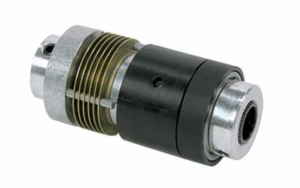Motion control is a big part of an automated processing line’s default feature set. Parts move fractionally or several metres, then they spin or activate a magnetic hinge. Indeed, there are challenges to overcome here, and the clutch system ranks high among them. With this in mind, ENKOSI has answered the challenge by introducing a wide range of pneumatic slip clutches. From Dynatect, here’s the perfect clutch for any manufacturing application.
Introducing the PolyClutch Line
Power-transmitting machine shafts vary in size while equipment velocities rise and fall. Multistage operations threaten to overwhelm mechanical assemblies, and hard-working servo motors are pushed to their limits. The Series 16 pneumatic slip clutch family is built to smoothly engage or disengage equipment power so that the next motion control operation can proceed without interruption. Designed to accommodate differently sized shafts (up to 10-mm), compact Series 16 units are built to handle up to 1.2-Nm of radial force while they manipulate large or small mechanical loads.
PolyClutch Pneumatics
Further into the slip clutch portfolio, pneumatic Slip-Aire devices operate off of compressed air instead of mechanical power. Even so, their inner workings are still inspired by the Slippers, Slip-Ease, Series 16, and other mechanical members of the Dynatect range of precision-tuned clutches. They use a miniature pneumatic piston to intelligently deliver continuous or intermittent transitional motion, incorporate a soft-cushioned start and stop feature, and handle large amounts of equipment torque with delicate checking force. Reading on from here, from the Slippers and Slip-Aire devices and their peers, let’s see what applications gain enhanced performance characteristics when one or more of these devices is installed.
Slip Clutching Applications Aplenty
Delivering force and torque control, plus a healthy measure of inertia control, pneumatic slip clutches have a role to play inside countless automated machines. A standard door opening mechanism, seen as a silver box and hinged arm, uses a slip control feature to provide overload protection when an automated doorway is obstructed. Ice vending machines and conveyor systems, bottle capping equipment and automated assembly line grippers, all of these mechanical systems gain an extra level of refined operate-ability when they incorporate air-actuated slip clutches.
Machines would function very differently without clutches. Their ability to vary the transmission of mechanical energy would be hard to replace. Likewise, slip clutches are essential machine components. Imagine a drive system that was directly coupled to its power train. If there was an obstruction, or even a need to change direction, the machinery would have to shut down while the gears were realigned. With these devices, though, as distributed by ENKOSI, system-interposing pneumatic slip clutches add many control features to otherwise inflexible mechanical assemblies.
For more information, download the pneumatic slip clutch catalogue, visit our Dynatect page or contact us.


